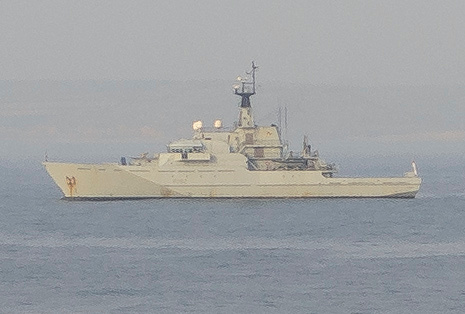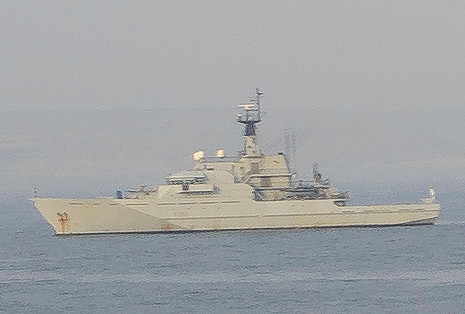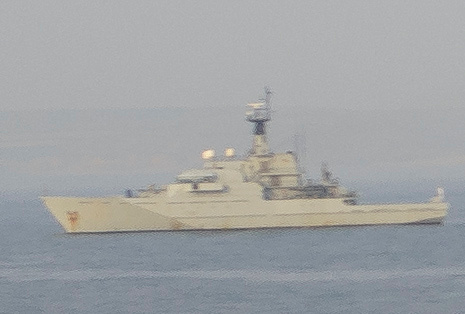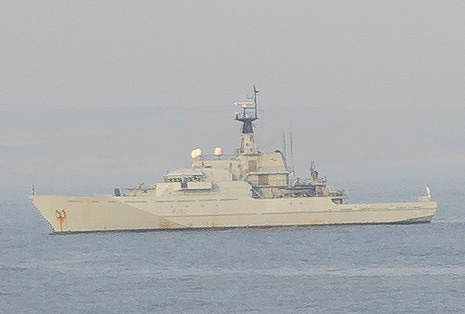D800 Left Point focus or focus and recompose?A brief post. People have been suggesting that if the left-most point is screwed (as a number appear to be) then they will simply 'focus and recompose'. These people may or may not understand that different lenses have differently shaped 'fields of focus' and that these are often curved, rather than planar - especially with fast, wide lenses. This means that the same subject will often require a different focus setting on the lens barrel when placed under the left-most point compared to when it is placed under the centre point. So I decided to see if 'focus and recompose' would work on the 28mm F1.8 lens, using a real-world target. It certainly doesn't work particularly well with test targets at close distances. So I set up a tripod and used a ship, floating about 1/4 mile away. It has horizontal and vertical detail and it fits entirely within the focus rectangle, water line included. First shot is with the ship under the centre point, viewfinder AF at f5.6 and is pretty acceptably sharp given that this is 100% crop. my usual settings for these tests: no lens corrections - they can distort the mid field - and LR4 sharpening of 90/0.7/70/20
Second shot is then made with no change in focus, but the camera swivelled on the tripod until the ship is under the left-most point. This exactly replicates the 'focus and recompose' method:
Third shot is with the camera still swivelled so that the ship is under the left-most point, but using Viewfinder (Phase Detect) AF with that left-most point:
Final shot is with the camera position unchanged, so the ship is still under the left-most point, but using zoomed Live View Manual Focus to show that this part of the lens is perfectly capable, at least at this distance and aperture, of sharp rendition of the subject: it is at least as sharp as the centre point AF shot.
These results are from a 'twice-baked' D800 (i.e. one that has been in to be 'fixed' for the Left Point AF problem twice). They clearly show that focus and recompose, even with a lens with field curvature, is better than using an inaccurate left-point - but that it is still not as good as the lens can do. Therefore I conclude that focus and recompose is a temporary solution only for users of such lenses, failing to offer the accuracy of which the lens is capable. I have run similar series at different apertures, subjects, and subject distances and got similar results. Moral: if your left AF is 'off' then don't believe that focus and recompose will save your ass. It won't. EDIT: I chose a distant subject here so as not to muddy the waters with the complicated issue of 'cosine error' but the issue has come up a lot in discussion since the post so here, for those unfamiliar with it, is a link to a brief primer: http://www.bobatkins.com/photography/technical/focus_recompose.html And here is a link to the Hasselblad system that corrects for it: and Hasselblad introduced this solution because studio photographers felt there was a problem! http://press.hasselblad.com/media-library/background-articles/true-focus.aspx Some further comments: the issue is complicated by the fact that given the physical displacement of the centre from the peripheral points, the distances from any of them to the subject will vary by up to several millimetres. That can affect the accuracy of focus of a fast wide, shot wide open, on an eye. Some photographers claim to be able to minutely 'rock' their bodies forwards or backwards so as to compensate for this. I am not so well calibrated. Some lenses may have field curvature, which generally in fast wides causes the peripheries of a lens to focus close than the centre. Clearly when executing an F&R manouvre, this can be a factor too, depending on the angles involved and the degree of arc involved, but may help compensate. In practice, however, greater than any of these issues is likely to be the fact that both model and photographer are likely to to be moving by small amounts in the two other planes as the manouvre is carried out. The model is moving however you choose to focus, but F&R does increase the risk of the photographer's motion impacting the accuracy of focus. None of these errors is significant at distance because the percentage of the error to the distance involved is smaller, and the DOF greater.
|




